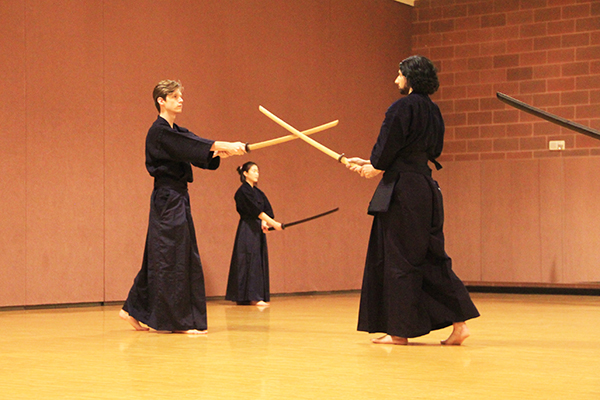
Cole Judge (left) and Justin Angra practice the different movements of kendo while at practice in the RPAC on February 25th, 2016.
Learning the ways of the samurai and making new friends while doing it: That is what the Kendo Club at Ohio State does.
Dennie Patton, a graduate student in physics and president of the Kendo Club, said that kendo means “the way of the sword” in Japanese.
“It’s literally what samurai trained in; after samurai swords were taken away in Japan, they wanted to keep their art alive, so they started practicing with wooden bamboo,” he said. “And then it’s the same sort of military tradition and fighting style that was taught to armies back in the day in Japan.”
Kendo is about training with the sword and also about training the mind and spirit, Patton said. People who practice kendo, known as kendoka, need to know how to remain calm and perform in good spirit.
OSU’s Kendo Club is a part of the East Central United States Kendo Federation, which hosts regional kendo tournaments. The next one is set to be held at Eastern Kentucky University on March 12 and 13, according to the ECUSKF website.
Competitions are full contact, and the kendoka wear bogu, or armor, and use a shinai, or the kendo sword. The outfit is flexible and allows competitors to simulate combat with full power without really hurting their opponent. Points are awarded to those who would have killed their opponents in real battle without getting killed in the process.
“Even though you’re trying to win, you’re not allowed to express it … there’s like a lot of respect and code-of-honor type stuff,” said Eunice Park, a first-year in exploration and vice president of the club.
“If you kill them and then stop to gloat, you don’t get a point,” Patton added. “The mindset is ‘battlefield.’”
At these tournaments, there are two different ways of competing: as individuals fighting one-on-one or team competitions. The one-on-one competitions are single elimination matches, and the first person to two points wins the match, said Justin Angra, a fifth-year in physics and mathematics. The team fights, however, are done differently.
“For the five team fights, it’s literally, for Kentucky at least, it’s last man standing, so the first person goes in and they stay in until they actually go out,” said Angra, who is also a member of the Kendo Club.
At these tournaments, members can also test to achieve one of eight ranks. For the majority of these tests there is a written exam, and participants have to take part in a sparring match. If they pass the sparring, then they go on to performing the kata, which are different patterns that show the kendoka’s swordsmanship.
Kendo Club practices Tuesday and Thursday from 5:30 to 6:30 p.m. in MPR4 East. Sunday practice is from noon to 2 p.m. in MPR5 (A200).
“It’s a great challenge, physically and mentally, you get to meet a lot of people and you get to learn about a lot of things, like the area and culture of Japan,” Angra said.


